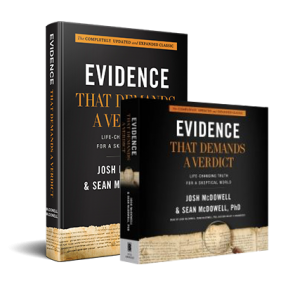
Did the Israelites Flee Egypt for the Promised Land?
In our last blog post we looked at whether there is definitive proof that Adam and Eve existed as real people. In this blog post we’ll look at what proof exists for the mass Exodus of the Israelites from Egypt.
No doubt about it, the Exodus of the Israelites, an event the Bible describes in great detail, is one of the most important historical events for both the Jewish and Christian faiths. Why? Because this central experience of rescue for the helpless out of a desperate condition has been recognized as a key example of God’s love.
Too, it is an example of God asserting His supremacy. In each plague He sends, God repeats this message: “I alone am God.” And in each miracle He provides for the Israelites as they flee Pharaoh’s pursuit, God reminds them that “I am who I am!“
The Bible tells us that Pharaoh — considered a god by his people — was specifically placed on the throne by God for the big showdown with Moses. God brought 10 plagues that showcased His power and motivated the Egyptians to be really willing to let the Israelites go.
Let’s look at the Exodus details, and then at existing evidence for the event. Its symbolism alone makes the Exodus story invaluable.
The Exodus Story
It is in Exodus 3:7-8 that we see God speak after He decides to take action:
“I have surely seen the affliction of My people who are in Egypt, and have heard their cry because of their taskmasters, for I know their sorrows. So I have come down to deliver them out of the hand of the Egyptians, and to bring them up from that land to a good and large land, to a land flowing with milk and honey.”
So God sends the 10 plagues, which the Egyptians dismiss until the pain finally cuts too close to the bone. Gnats didn’t move them. Flies didn’t move them. Neither did thick darkness. Not even the decimation of Egyptian crops and cattle motivated Pharaoh to agree to God’s demand to “Let my people go!” (Cue Charlton Heston.)
Only at the last plague — during which every Egyptian firstborn dies — do the now shellshocked Egyptians finally beg the Israelites to get the heck out of Dodge. They even dump parting gifts of silver, gold, and clothing on them. (Unfortunately, the Israelites later sinned with the help of all that gold.)
An interesting GotQuestions.org article sheds light on why God may have cherry-picked each plague. Examples: The second plague, of frogs from the Nile, was a judgment against Heqet, the frog-headed goddess of birth. Egyptians viewed frogs as sacred, and not to be killed. Yet God used the frogs to make a stench in the nostrils of the Egyptians, as they piled the dead, rotting frogs into heaps across the land (Exodus 8:13–14). The ninth plague, of thick darkness, was aimed at blasting the sun god, Ra, symbolized by Pharaoh himself. For three days, the land of Egypt was “smothered with an unearthly darkness, but the homes of the Israelites had light.” The tenth plague, the death of all firstborn males, was a smackdown on Isis, the supposed protector of children.
Pharaoh changes his tune from “Who is the Lord, that I should obey his voice and let Israel go? I do not know the Lord, and moreover, I will not let Israel go!” to “Leave! NOW!”
But almost immediately he changes his mind! Mighty Egypt had just given up its free labor force! ACK! So Pharaoh orders his army to warp speed to reclaim the slaves. God probably yawned at how little effort it took Him to stall their progress as He watched the Israelites walk between the watery walls of the Red Sea. Once they safely reached the shore, God again closed the Red Sea, drowning the entire Egyptian army. (Even with overacting by Heston and the rest of the Ten Commandments movie cast, this scene is impressive.)
The obvious symbolism: in the Old Testament we see God use Moses to lead the Israelites out of physical slavery. In the New Testament, we see God use His son to free all of humanity from spiritual slavery.
Archaeological Limits
Jews and Christians have, for centuries, embraced the Exodus story, because the Bible has proven itself trustworthy as a book of truth and fact.
Only in the last 20 years or so have scholars decided the event isn’t historical, due to lack of evidence. But, says scholar Anthony Frendo: “Israel must have somehow (at least partially) come from outside Canaan in view of the multiple texts in the Old Testament which point in this direction. Why should the Old Testament authors have made this up? Should we not try harder to understand our texts in connection with the results of good archaeology, rather than superficially to dismiss the former?”
Alan Millard of the University of Liverpool, says: “Lacking any trace of Joseph, Moses, or Israelites in Egypt, many have concluded they were never there. Yet no pharaoh would boast of the loss of his labor force on a monument, and administrative records on papyrus, leather, or wooden tablets which might have registered such events would perish rapidly in the Delta’s damp soil. It is equally unlikely that a camping crowd would leave recognizable remains from a semi-nomadic life in the Sinai Wilderness and in Transjordan. The absence of evidence is not, therefore, evidence of absence!”
Old Testament scholar and Egyptologist James Hoffmeier confirms that Goshen, in the Nile Delta, is quite moist due to rain and annual flooding. If the Israelites had been in the dry Southern region, where the Dead Sea scrolls have been uncovered, he is certain papyrus documents would have survived. “We have to be realistic,” he adds, “about what we think archaeology can and can’t do.”
“Archaeological discoveries have verified that parts of the Biblical Exodus are historically accurate, but archaeology can’t tell us everything, agrees the Biblical Archaeological Society. “Although archaeology can illuminate aspects of the past and bring parts of history to life, it has its limits.”
Limited evidence does not mean the event didn’t happen as the Bible tells it.
Proof for the Plagues, Then?
Again, hard to prove. But some scholars give credence to naturalistic phenomenon, which God certainly could have used to achieve His goal.
Hoffmeier explains: “Some have theorized that the first plague — in which the Nile turns blood red — is associated with the presence of microscopic flagellates in the water that account for the color. This phenomenon is associated with the annual inundation of the Nile that begins in August, crests in September, and ends in October. These microbes consume large amounts of oxygen from the water which results in fish dying and causes a rank smell, rendering the water undrinkable as described in the Bible (Exodus 7:21). If indeed a contaminated annual flood marked the beginning of the plagues, which would have begun in the period of August to October, and since Passover is observed in the period March-April (that is, seven to nine months later), the ninth plague — three days of darkness — might have been caused by a severe dust storm or khamsin. Such dust storms can still blanket Egypt for days at a time during the months of March and April. They even darken the sun and fine dust covers everything. This scenario for the ninth plague certainly fits the description that it was a darkness to be felt (Exodus 10:21). By using the forces of nature against Egypt, the God of Israel demonstrated His superiority over the gods of Egypt and over Pharaoh, who was responsible for maintaining cosmic order in the land.”
How often, we wonder, does God use “the forces of nature” to make His point? But like the Egyptians, we often refuse to acknowledge the Hand of God until the pain becomes excruciatingly personal. Only then do we move.
Taking the Bible as Truth
We find the Exodus mentioned as a historical event throughout the Old Testament, including the books of Psalms, Joshua, Judges, 1-2 Samuel, 1-2 Kings, and in the Prophets. We should note that the Bible is not a single source document. It is multiple sources, all of which maintain the authenticity of the Exodus tradition. Historians recognize that the likelihood of the authenticity of an event increases as independent sources that verify it are discovered.
Scholars cannot concretely prove that Moses existed, that Israel lived in Egypt, or that they fled from Pharaoh. But neither can they disprove the historicity of the biblical narrative.
As Hoffmeier notes:
“With this overwhelming evidence within the Bible regarding the Egyptian sojourn, exodus, and wilderness episodes, evidence coming from a variety of types of literature and used in a host of different ways, it is methodologically inadvisable, at best, to treat the Bible as a single witness to history, requiring corroboration before the Egypt-Sinai reports can be taken as authentic.” He adds, “Many people today treat the Bible as being guilty until proven innocent. Which doesn’t seem fair, as who’s around to prove it that lived back then?”
Simply put, there is enough evidence contained in the Bible to make the story believable. It is likely such a man as Moses existed, a people such as Israel lived in Egypt, and they left Egypt via the route detailed in the Bible.

This blog post highlights Josh and Sean McDowell’s recently revised apologetics classic, Evidence That Demands a Verdict. We are certain this fully updated and expanded resource will be an effective evangelism tool for you, and strengthen your faith by answering the toughest questions tossed to you by skeptics. Know what you know, because it’s true. But share this truth with LOVE!
If you’d like to start from the first blog post in this series, click here: Apologetics: Apologizing for Believing in God?.



